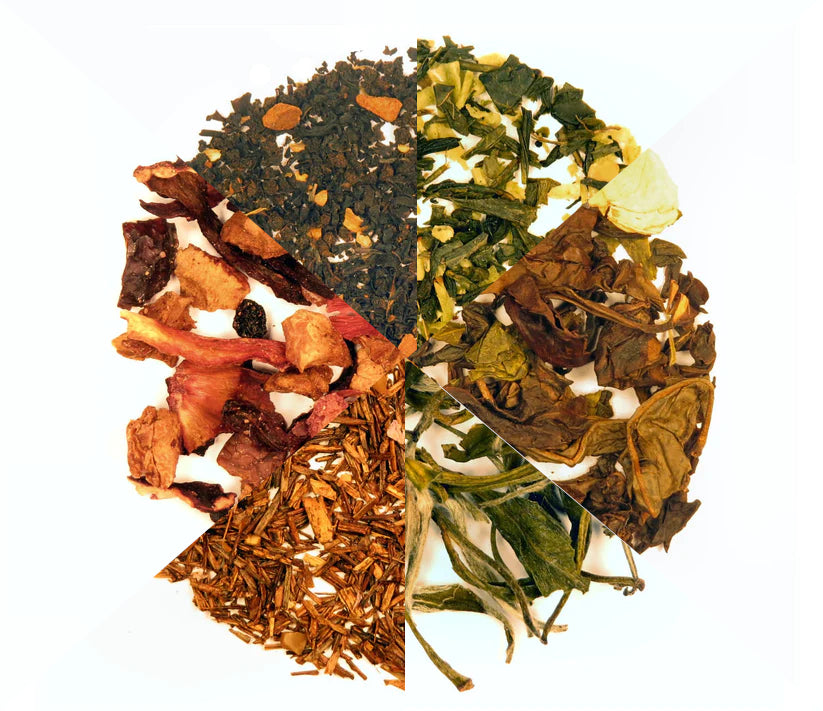Tea Classifications
If all tea comes from the same plant, where do all the color designations come into play? There are a number of ways to process tea leaves that can cause quite a different result.
Tea processing occurs in five basic steps:
- Plucking
- Withering (allowing the leaves to wilt and soften)
- Rolling (to shape the leaves)
- Oxidizing (allowing oxygen to bombard the chemicals in the leaf)
- Firing (drying)
Oxidation is the biggest factor in determining color classifications. Oxidation occurs when enzymes in the leaf are exposed to oxygen. This process can be forced quickly with breaking, crushing, or rolling the leaves or drawn out slowly through natural decomposition. Tea oxidation is considered slow oxidation. Fire is a form of rapid oxidation. If left unchecked, the oxidation process would destroy the leaves and leave nothing left to steep. The oxidation process is halted by raising the temperature of the leaves, usually by firing or pan frying.
Oxidation is often referred to as "fermentation." It was once thought that tea leaves were fermented much like grapes into wine, but we now know differently. Even today, many in the tea industry refer to the oxidation process as fermentation.
The five basic styles of tea are White, Green, Oolong, Black, and Pu'erh.
White Tea
White tea is the least processed of the teas. The name comes from the fuzzy white "down" that is often found on the opened buds or tips of the bush. White is plucked and withered. Other than a safe CO2 decaffeination process, that's basically the entire process. White tea is not rolled or shaped, giving it its natural appearance to leaves. The drying process can take a day or two to occur causing some oxidation. This is why some white teas, such as White Peony, can have different color leaves, such as green, white or brown. White tea has a light and airy flavor and typically does not become bitter when steeping.
Green Tea
Green tea is plucked, withered, and rolled. The rolling process would normally start oxidation but to prevent this from occurring, tea leaves are simultaneously heated or steamed. This usually occurs in large woks where temperatures raise high enough to kill the enzyme that allows for oxidation. The leaves are pressed and rolled against the sides of the wok and give green tea its characteristic shape. The liquor color of green tea typically consists of green or yellowish tones and flavors range from grassy to a vegetable-like astringency.
Oolong Tea
Oolong tea is the most laborious tea to process. It uses all five basic steps, with rolling and oxidizing being done repeated. The teas oxidation can be anywhere from 8% to 80%, depending on desired result. "Jade" oolongs are barely oxidized, keeping the leaves green. The oxidation process can last between several hours to several days. Oolong teas have a complex taste with a soft astringency. They are priced for their smoothness and are a great tea for beginners.
Black Tea
Black tea also uses all five steps, but is allowed to oxidize completely. Often referred to as "fully oxidized", they are generally not oxidized repeatedly, but in one straight process. The tea is made complete within a single day. The liquor of black can range from brown to deep red. This is often why the Chinese refer to black tea as red tea, while we name the tea based off the color of the leaves, they name it based off the color of the steeped liquor.
Pu'erh Tea
Pu'erh Tea is a unique tea and an art form by it's own right. It undergoes a process similar to Green tea, but before the leaf is dried, it's aged as loose tea or pressed into cake or other decorative shapes. Pu'erh was even used as a currency in China many years ago. Pu'erh is considered a fermented tea, in the correct sense of the word, although it does not produce alcohol. Some Pu'erh teas are dark "ripe" while others maintain a green or "raw" pu'erh classification. Very prized pu'erh teas are hundreds of years old and can be sold for thousands of colors per pound. Common pu'erhs can be aged between a few months to 10 years. Pu'erh has a woodsy or earthy flavor and are considered rich and smooth tasting.
More tea fun:
What is tea?
Types of tea
Health benefits
Caffeine in tea
Iced tea
Packaging
Loose Leaf Tea over Teabags
FAQs


